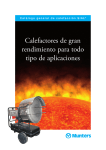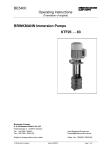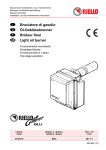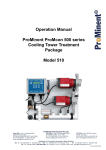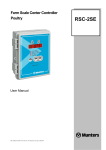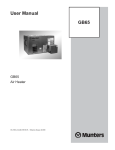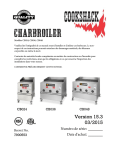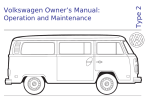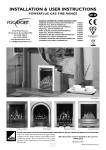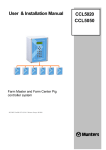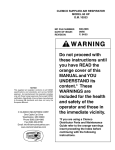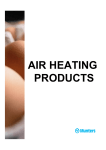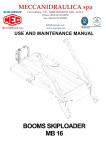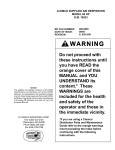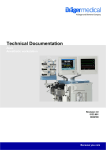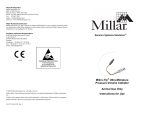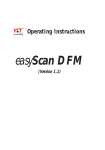Download FA6 Evaporative Humidifier, technical manual
Transcript
Evaporative Humidifier/Cooler FA6 for AHU’s Technical manual HC/MMA/TGB-1711-06/10 pdf SOS ReklamStudio FA6 Disclaimer Munters reserves the right to make alterations to specifications, quantities, dimensions etc. for production or other reasons, subsequent to publication. The information contained herein has been prepared by qualified experts within Munters. While we believe the information is accurate and complete, we make no warranty or representation for any particular purposes. The information is offered in good faith and with the understanding that any use of the units or accessories in breach of the directions and warnings in this document is at the sole discretion and risk of the user. This manual has been prepared in English as original language. © Munters Europe AB 2010 Contents FA6 Evaporative humidifier/Cooler Introduction Introduction Technology basics Standard sizes Simple to install Technical specification Design and operation Circulating-water models Bleed-off flow Control system On/off control Step control Face and by-pass control Dew-point control Options BMS integration and improved hygiene 4 4 5 5 5 6 7 7 8 9 10 10 11 11 12 FA6 Clean Concept FA6 Dosing System FA6 UV sterlilization system FA6cs Conductivity System Dimensioning 12 How to select your FA6 Size selection program Dimensioning example Charts for Humidifier sizing Dimensions, weight and pump sizes Water quality / data Table and example Water from other sources Total water consumption for direct-supply-water model – table Pressure requirements at water supply connection point without CC unit Water consumption 13–14 15 16 16 16 16 17 18 Direct water model Circulating water model Bleed-off factor Example Water quality 18 Water from other sources General water hardness conversion table Ordering key 19 Design standards, approvals and certifications 19 3 FA6 Evaporative humidifier/cooler A A = Warm and Dry air B = Cold and Humid air B Circulating-water system Introduction The Munters evaporative FA6 humidifier/cooler has been specially designed for integration into air-handling units within both residential and industrial buildings. The design is compact and sizes conform to all typical air handling units (AHU). The standard product line encompasses a wide range of sizes, options, for multistage control integrated droplet separator and three nominal humidity efficiencies of 65%, 85%, 95%. There are also two different models for either direct water or circulating water. The airflow range is between 0.5 and 34 m3/s. The external dimensions of the smallest humidifier are 0.6 x 0.6 m; the largest 3x3 m. The recommended air velocity through the media is up to 3.5 m/s without the droplet separator (DropSTOP), and up to 4.5 m/s with Dropstop™. 4 Air-flow range, 0.5–34 m3/s Nominal humidification efficiency: 65%, 85% and 95% Humidifier cassettes of non combustible GLASdek® Designed with circulation or direct water systems With or without droplet separator, DropSTOP™ Adapted for dew-point, stepped, face and by-pass control, or On-Off control • Complete emptying of bottom tray • Simple maintenance • Comprehensive accessories available. • • • • • • Technology basics The heart of FA6 is a cassette made from inorganic non combustible evaporative media – GLASdek®. Water is supplied to the top of the GLASdek evaporative media via a distribution header. The water flows down the corrugated surface of the media. As the warm and dry air passes through the media it evaporates a proportion of the water and thus produces cold, humidified air. The rest of the water assists in washing the media, and is drained back to the tray. The energy that is needed for the evaporation is taken from the air itself. The air that leaves the humidifier is therefore humidified and cooled simultaneously without any external energy supply for the evaporation. This is in essence the adiabatic cooling process. It is very efficient and the consumption of energy is very low. It also allows the use of water straight from the tap with no need for water treatment (i.e. demineralisation plants). Minerals and pollutants stay behind in the GLASdek evaporative media to be washed away with the discharge water keeping the total humidification process pure. The principle of evaporative humidifictaion and cooling (the adiabatic cooling process). Standard sizes Wide range of sizes FA6 comes in a wide range of standard sizes that conform to all typical air handling unit dimensions. The individual units cover air volumes from 0.5-34 m3/s. For very large air volumes a combination of units is selected in order to achieve the desired size. Non-standard sizes are available upon request. Selecting the optimal size is easy with the FA6 Dimensioning Program or your Munters contact person can help you. Simple to install The FA6 is easy to install and easy to configure into both existing and new HVAC systems. For installation you need to have access to electricity (400V/50 Hz) and (230V/50 Hz) as standard for pump and solenoid valves. Pump for (230V/50 Hz) or (120V/60 Hz) and solenoid valves for (24V AC) are available as option. Water supply (1-10 bar) and drainage (Ø 50 mm/2”). Connect to existing BMS/control system or Munters can supply a new control system for the control of humidifier/cooler. Due to its high performance and compact design it is the ideal replacement for older, less efficient humidifiers/coolers. B, height [cm] A, width [cm] 60 90 120 60 0.9 1.6 2.4 90 1.2 2.3 3.4 120 1.7 150 180 210 240 270 300 Air volume [m3/s at 4.5 m/s] 3.2 4.7 150 3.9 5.8 7.6 9.5 11.3 13.2 180 4.8 7.1 9.3 11.6 13.8 16.0 210 8.1 10.7 13.3 15.9 18.5 240 9.4 12.4 15.4 18.4 21.4 24.4 270 10.5 13.8 17.2 20.5 23.9 27.2 300 11.8 15.5 19.3 23.0 26.7 30.5 34.2 Customized sizes on request are available contact your Munters contact person. 5 Technical specifications Connection points and access space requirements for service 1. 2. 3. 4. 5. Electrical data – circulation pump Sound attenuation* Pump size (ref. p. 9) 8 KTF16 9 KTF51 10 KTF81 11 KTF82 Voltage V ±10% 3-phase ∆230/Y400 3-phase ∆230/Y400 3-phase ∆230/Y400 3-phase ∆230/Y400 Frequency Hz Power W Rated current A 50 49 0.26/0.15 50 75 0.38/0.22 50 140 0.71/0.41 50–60 220 0.95/0.55 Supply air Humidified air Electrical connection point for pump Cold-water connection female threaded coupling, 1/2” 18 mm Discharge pipe with a rubber socket for piping with dimension d=50 mm / 2”. 6. Access for inspection and servicing Integral attenuation, dB Octave band Hz 63 125 250 FA6-65 3 2 2 500 1,000 2,000 4,000 8,000 2 4 5 8 10 FA6-85 3 2 2 3 5 6 12 15 FA6-95 3 2 3 3 5 7 13 16 *) Sound level for FA6 unit is not above 70 dB. Maximum continuous operating temperature Electrical – solenoid valve for step control Air Water Frequency Hz Power W GLASdek 200 °C 40 °C Mesh reinforced plastic hose 50 °C 50 °C 1-phase 230 V(AC) 50–60 43/24 PVC pipes 50 °C 50 °C 24 V(AC) 50–60 15 Circulation pump ON 40 °C 80 °C Circulation pump OFF 75 °C 80 °C Voltage V ±10% Drain capacity Bottom valve only 30 l/min Overflow protection only 30 l/min Bottom valve + overflow protection 60 l/min Stated drain capacity is valid when using 50mm drain pipes. 6 IP classes Pump 54 Solenoid valve 65 Drain valve 54 Design and operation Two different types of systems are available Circulating water or Direct water. Circulating water FA6 units A circulating water system is recommended to most applications/sizes to ensure low water consumption and low life cycle cost. Direct water FA6 units Direct water systems are commonly used when the water quality is too poor for circulating systems or when the humidifiers’ annual operation time is short. Direct water system are not available in all sizes, see chart on page 17. Circulating-water models The tray is filled with cold water from the mains and the water level is maintained by the level switch and solenoid valve. When there is a demand for humidification, the pump starts and delivers water to the water distribution assembly where it is supplied to the water distribution header. Each water distribution header assembly supplies sufficient water to the humidifier cassette. The water then flows down through the corrugated surface of the humidifier cassette. Some of the water is absorbed by the GLASdek® media and the rest runs down into the bottom tray. As the supply air passes through the media, a proportion of the water absorbed by the media evaporates on contact with the air to produce humidified air. Direct-water-supply models The direct-water model does not have a water pump, therefore it is essential that the mains cold-water supply connected to the unit has adequate pressure and flow rate for the humidifier being installed. Mains cold water is supplied to the unit and is fed to the water distribution header via a constant flow valve. The constant flow valve ensures that the correct flow rate is supplied to the water distribution header of each cassette. The water flows downward through the corrugated surface of the humidifier cassette. Some of the water is absorbed by the GLASdek media and the rest runs down into the bottom tray. As the supply air passes through the humidifier, a proportion of the water absorbed by the media evaporates on contact with the air to produce humidified air. The water that reaches the bottom tray is discharged directly to the wastewater system through the discharge pipe. 7 Design and operation Circulating Direct 2 2 2 1 1 3 7 3 1 5 3 3 9 10 8 4 13 D 2 11 5 C C 4 6 5 8 12 7 6 D Function diagram C Mains Cold-Water D Discharge Water 1 Humidifier Cassette 2 Water-Distribution Header Assembly 3 Water-Distribution Hose 4 Level switch 5 Water inlet solenoid valve 6 Reservoir Drain Valve 7 Bleed-off Drain 8 Water-Distribution Assembly 9 Bleed-off Control Valve 10 Pump 11 Discharge Pipe 12 Overflow Outlet 13 Pressure reduction Bleed-off flow Regular cold water from city mains contains a certain amount of minerals and salts, the concentration of which varies from place to place. During evaporation, pure water is released to the air. The minerals and salts remain in the water and are returned to the water reservoir. The concentration in the reservoir water therefore becomes higher than the supply water. If the mineral concentration (especially calcium) becomes too high, scale deposits may form on the surface of the media until they finally clog the humidifier. To combat the problem, a pro- 8 C Mains Cold-Water D Discharge Water 1 Humidifier Cassette 2 Water-Distribution Header Assembly 3 Water-Distribution Hose 4 Mains Water Connection 5 Constant Flow Valve 6 Water Distribution Assembly 7 Discharge Pipe 8 Overflow Outlet portion of the reservoir water must be drained and replaced with fresh water. The water that is drained off through the bleed-off valve via the bleed-off hose to the discharge pipe is called the bleed-off flow. The bleed-off flow rate is regulated using the bleed-off valve, so that the mineral concentration is kept at an acceptable level. Before the humidifier can be started up, the bleed-off flow rate must be calculated and set in accordance with the instructions on page 18 and in page 13 in FA6 installation/service manual. Control systems There are four different Control systems available to control the humidity. The FA6 can be easily controlled to address even the most demanding conditions. The choice of control method depends mainly on the application and the desired accuracy of the system. On-Off control system accuracy typical 5-10% relative humidity RH. Stage Control controlling the individual cassettes, accuracy typical 3-5% RH. Face and By pass the infinitely variable for very exact accuracy 1-2% RH. Dew point Control measures the absolute humidity of the air from the humidifier and controls the pre-heater and re-heater to achieve the set value accuracy 1-2% RH. GX On-Off (1-stage) Stage Control (2-5 stages) Face and By pass*) Dew point Control*) On-off control Operation The humidity sensor, GRh, measures the relative humidity in the room (or exhaust duct) and switches all the cassettes either on or off, to achieve a humidity level within the set lower and upper limit values. The temperature sensor, GT, measures the temperature downstream of the supply-air fan and controls the preheater, to achieve the set value. When humidity is required, the humidifier pump starts and all the cassettes are supplied with water. The RH level in the room rises relatively quickly to the set upper limit, since all the cassettes are in operation. The pump then stops and all the cassettes are taken out of operation. The RH level in the room then falls, reaching after some time the lower set value. The pump will then start again, stopping when the upper limit value has been reached. The operating conditions of the system for varying ambient air humidity can be found in the ps chart. Control properties An on-off control system provides an RH level in the room during the day that varies between the set maximum and minimum values independent of the humidity of the ambient air. The system starts and stops several times a day regardless of the actual humidity of the ambient air. The result in practice is a control accuracy of ±5-10 percentage points RH. Operating time Since the humidifier is greatly over-engineered for most of the year, the start and stop frequency will be high. The tighter the set tolerances (start and stop difference), the higher the start and stop frequency. In times of highly humid ambient air, the on interval for the humidifier is shorter than the off interval. When the humidity of ambient air is low, these conditions are reversed. GT GRh 9 Step control Operation The humidity sensor, GRh, measures the relative humidity in the room (or exhaust duct) and opens the necessary solenoid valves, to achieve a humidity level within the set lower and upper limit values. The temperature sensor, GT (a mean-value type), measures the temperature downstream of the supply-airfan and controls the preheater, to maintain the set value. When humidity is required, the humidifier pump starts and the cassettes without solenoid valves are supplied with water. The dimensions of these cassettes are chosen so that the RH level in the room rises to just under the upper set limit value. If the humidity of the ambient air drops, the RH level in the room falls. The relative-humidity sensor, GRh, opens the first solenoid valve when the level has reached the lower limit value. The size of the cassette for this solenoid has been chosen so that the RH level now rises again to just under the upper set limit value. This sequence is repeated until all the solenoid valves are open. The operating conditions of the system for varying ambient air humidity can be found in the ps chart. Control properties A system using step control provides RH level in the room during the day that varies between the set maximum and minimum values depending on the actual humidity of the ambient air. Four steps normally provide a control accuracy of ±3-5 percentage points RH. The tighter the tolerances for set maximum and minimum values, the more steps are required. Operating time A defined step relates to a certain humidity interval of the ambient air. During the spring, therefore, only one cassette is in operation. During the winter, four cassettes are in operation. Please see the diagram. This method of operation will minimize starts and stops. And this will increase the service life of the cassettes. Furthermore, the operating time for the cassettes is on average only half of what it is for the cassettes in a dewpoint system. GT GRh Face and by-pass control Operation The humidity sensor, GRh, measures the relative humidity in the room (or exhaust duct) and opens the necessary number of solenoid valves as well as the face damper, or gradually closes the by-pass damper, to maintain the set value. The temperature sensor, GT (a mean-value type), measures the temperature downstream of the supply-air fan and controls the preheater, to maintain the set value. When humidity is required, the humidifier pump starts, supplying the cassette situated downstream of the face damper. When the face damper is fully open and there is a continued demand for humidification, one of the solenoid valves is opened and the face and by-pass dampers return to their original positions. Should additional humidity continue to be required, the face damper gradually opens and the by-pass damper closes to a corresponding degree. When the face damper has opened completely, the next solenoid opens and the face and by-pass dampers again return to their original positions. This sequence is repeated until all the solenoid valves have opened. The operating conditions of the system for varying ambient air humidity can be found in the ps chart. 10 Control properties A Face and by-pass system provides an almost constant RH level in the room during the day regardless of the actual humidity of the ambient air. The result in practice is a control accuracy of ±1–2 percentage points RH. Note however that it is not possible to achieve the set humidity for the room, without pre-cooling, for conditions whereby the ambient air has a higher wet-bulb temperature than the room’s wetbulb temperature. Operating time This method of operation will minimize starts and stops and increase the service life of the cassettes. Furthermore, the operating time for the cassettes is on average only half of what it is for the cassettes in a dew-point system. The system is highly cost effective compared with dewpoint regulation, since there is no after-heater nor shunt unit. GT GRh Dew point control Note however that it is not possible to achieve the set humidity for the room, without pre-cooling, for conditions when the ambient air is above an imaginary line between the room dew point and the condition before the humidifier at design ambient air humidity. Operation The dew-point sensor GX, measures the absolute humidity of the air from the humidifier and controls the pre-heater to achieve the set value. The temperature sensor, GT, measures the temperature of the supply air downstream of the inlet fan and controls the post heater to achieve the set value. When humidity is required, the humidifier pump starts, and water is supplied to all the cassettes. The operating characteristics of the system for varying ambient air humidity can be found in the ps. chart below. Operating time Operation of the unit utilizes all of the humidifier cassettes as soon as a need for humidity exists. GX Control properties A dew-point system provides an almost constant Rh level in the room during the day regardless of the actual humidity of the ambient air. The result in practice is a control accuracy of ±1–2 percentage points RH. GT Note A constant interval heat load is assumed for a constant room temperature. If this is not the case, a room-temperature sensor should be added. Options The customer-order models and accessories below have been described only briefly. Please contact your local Munters office for additional information. Height The FA6 is available in special heights in case it is necessary to utilize the maximum height of the air-conditioning unit. High temperature Direct water models can be adapted for high temperature applications (100 °C). Normally used in recirculation paintbooths where high temperatures occur during the drying cycle. Special cassette sets Each standard size FA6 has a specific number of 300 mm or 600 mm wide cassettes. For applications requiring close control, two 300 mm cassettes may be used to replace a single 600 mm cassette. Additional solenoid valve must then be installed for each cassette. Pump motor and special electrical data The standard pump has a motor designed for 3-phase, 400V/50 Hz operation or 3-phase 230V/50 Hz. Motors for 3-phase operation using other voltages and/or frequencies are available, as are motors for 1-phase, 230V/50 Hz and 120/V60 Hz operation. Constant-flow valves Specially designed constant-flow valves for systems using direct-water are available. If a humidifier is to be used for indi- rect evaporative cooling utilizing direct water, the constantflow valves can be designed for half the nominal flow. Droplet separators Used to eliminate the risk of carry-over due to high air velocities or turbulent airflow. They are very easy to install and do not change the FA6 humidifier’s space requirement. Droplet separators are recommended for all installations with a face velocity over 3.5 m/s. Total Emptying of water distribution according to VDI 6022 German requirements. Direct water units can be ordered with a special designed distribution pipe. The distribution pipe is equipped with motorized drain valve for automatic drainage. For total emptying of distribution pipes after shutdown. External pump station For extra high service availability Munters can supply an external pump station. Contact your Munters Contact person for details Control system for step control Control system for max 6 steps can be supplied. Number of steps depending on Humidifier size. Control system for face and Bypass Control system for max 6 steps and two outputs for damper actuator can be supplied. Number of steps depending on Humidifier size. 11 BMS integration and improved hygiene In most cases water treatments are not necessary, but in cases with poor water quality, it can be necessary to add a water treatment. FA6cc, Clean Concept A bolt on enhancement for the FA6 humidifier that enables circulating water models to operate at optimum hygiene levels. The system incorporates a control panel with BMS connections, electronic level control and automatic drainage of the reservoir. The system has options for boicide dosing and conductivity controlled bleed-off. FA6cc is designed to exceed current legislation in relation to the control of bacteria in water systems in many countries – e.g. ACOP L8 in the U.K For more information, please refer to the FA6cc technical manual. FA6 Dosing system The FA6ds, Dosing System is further enhancement of the FA6cc that enables time controlled, and/or externally controlled, dosing of biocides into the humidifier tray. The system is supplied with all the necessary parts required for connecting to the FA6 Evaporative Humidifier/Cooler, excluding the biocide with container. FA6 UV sterilization system A recirculating water UV sterilization system kills harmful bacteria and viruses in water using UV light. FA6cs, Conductivity System Enables conductivity controlled bleed-off. The system reduces water consumption and is especially effective with stage-controlled humidifier/coolers. Dimensioning How to select your FA6? Selection of the right FA6 unit is easy with the advanced FA6 Dimensioning Program. The program is based on weather data collected over many years for almost all locations globally. All you need to know are the following parameters: • Air volume • Duct dimensions or the cross-section of the AHU • Design conditions (location) • Required control accuracy • Type of application (Humidification/Cooling) • Required air conditions 12 FA6 Dimensioning program A Windows based program is available to help quickly select the right-sized FA6. The program provides correct humidity data and other relevant information required for the installation in question. The program can serve as a valuable supplement to this catalogue. Please contact your nearest sales office for additional information. Selection of humidifier size Calculating humidified air properties: Example Humidifier airflow range 0.5-4 m3/s Humidification efficiency η=82%. Supply air (winter) : t0=-5 °C and x0= 2.0 g/kg. η, % 100 FA6-95 90 FA6-85 80 t0 t1 t2 °C x0 x1 x2 g/kg 70 The outside supply air is pre-heated to: t1=35 °C and x1 = 2.0 g/kg, giving a wet-bulb temperature of tw=14.6 °C, and a saturated air content of xw=10.4 g/kg (see psychrometric chart below). The condition of the humidified air downstream of the humidifier can be calculated as: x2 = x1+η/100x (xw-x1) = 2.0+82/100x (10.4-2.0) = 8.9 g/kg t2 = t1+η/100x (tw-t1) = 35+82/100x (14.6-35) = 18.3 °C FA6-65 50 20 60 70 30 0 -12 180 80 90 40 0 -12 150 140 100 50 160 180 200 120 60 95% 140 85% 70 25 65% 150-090 0 0 -09 0-12 180 12 q, m3/s 0 0 -12 -15 210 150 120 100 50% 50 80 19 40% 15 40 70 70% 30 4 60 50 30 60% ∆p Pa 40 25 100% 90% 20 80% 60 18 090-120 17 120-090 16 20 3 15 30% 14 2.5 13 12 060-120/ 090-090 15 11 10 20 % 9 2 xw x2 10 8 7 120-060 6 5 060-090 5 10 0 1.5 % -5 090-060 -1 0 -1 5 4 3 - 10 2 x 0,x 1 1 0 -20 -15 -10 -5 t0 0 5 10 15 20 tw t2 25 30 35 40 t1 1 0.9 060-060 0.8 ok Definition of humidification efficiency, η % η=(x2-x1)/(xw-x1)¥100 0.7 0.6 0.5 2.0 2.5 3.0 3.5 4.0 v, m/s 4.5 Example The diagram shows if the selected humidifier is the FA6-85-090-120 equipped with a droplet separator: Airflow, q = 2.8 m3/s. Air velocity, v=3.6 m/s. Pressure drop humidifier, Δp85% = 92 Pa. Pressure drop droplet separator, Δp = 22 Pa. Humidification efficiency, η=82% 13 Charts for selection of Humidifier sizes Humidifier airflow range 4-10 m/s Humidifier airflow range 10-30 m/s 100 h, % η, % 100 FA6-95 90 FA6-85 80 70 60 60 FA6-65 50 25 30 70 40 15 80 50 20 100 60 70 30 120 80 90 40 140 100 50 160 180 200 120 60 95% 140 85% 70 40 30 15 65% 50 60 40 70 50 20 80 100 60 70 120 80 90 40 30 25 140 100 50 30 160 180 200 120 60 140 95% 85% 70 65% 9 30 027 0 30 030 0 150-180/ 240-120 180-150 q, m3/s 24 0-1 50 30 0-1 18 20 0 15 -180 0-2 10 21 027 150 0-1 20 -15 0 21 150-18 0-2 0 40 70 18 0-2 10 /2 30 0-1 0-2 80 10 /21 0-2 40 30 24 24 2 02 7 40 0-2 10 60 20 30 ∆p Pa 50 27 0-1 80 18 0-2 4 0 24 0-1 /210 -21 80 /30 0 0-1 50 40 ∆p Pa FA6-65 50 20 q, m3/s FA6-85 FA6-85 80 70 10 FA6-95 90 270-270 300-240 25 240-270 270-240 210-120 300-210 8 150-150 240-240 270-210 180-120 20 7 300-180 240-210/ 210-240 270-180 180-240/ 210-210 6 150-120 240-180/ 300-150 15 180-210/ 270-150 210-180 150-240 5 180-090 240-150 120-120 300-120 180-180 150-210 10 4 2.0 2.5 3.0 3.5 4.0 v, m/s 4.5 Droplet separator recommended for air velocities above 3.5 m/s. 14 2.0 2.5 3.0 3.5 4.0 v, m/s 4.5 Dimensions, weights and pump sizes Dimensions mm A B 060-060 060-090 060-120 600 600 900 1200 090-060 090-090 090-120 900 600 900 1200 120-060 120-090 120-120 1200 600 900 1200 Size 150-090 150-120 150-150 150-180 150-210 150-240 180-090 180-120 180-150 180-180 180-210 180-240 210-120 210-150 210-180 210-210 210-240 240-120 240-150 240-180 240-210 240-240 240-270 270-120 270-150 270-180 270-210 270-240 270-270 300-120 300-150 300-180 300-210 300-240 300-270 300-300 1500 1800 2100 2400 2700 3000 900 1200 1500 1800 2100 2400 Qty cassettes Width Width 300mm 600mm 1 1 900 1200 1500 1800 2100 2400 1200 1500 1800 2100 2400 1 1200 1500 1800 2100 2400 2700 3000 Dry Wet Dry FA6-95 C=730 mm, D=300 mm Pump size Weight kg Wet Dry 8 8 8 44 49 52 23 26 28 8 8 8 50 57 64 26 30 33 8 8 9 58 70 80 28 33 38 1 8 8 8 60 66 73 29 32 35 8 8 8 69 78 91 33 38 43 8 8 9 84 100 116 39 46 53 2 8 8 8 76 84 92 35 39 42 8 8 8 88 100 115 41 46 52 9 9 9 106 129 148 48 56 64 8 8 8 8 8 8 103 113 123 134 141 150 48 51 55 60 64 68 8 8 9 9 9 9 124 142 159 178 197 212 56 62 71 79 88 95 9 9 9 9 9 10 159 184 208 237 262 286 67 79 90 102 113 123 8 8 8 8 8 8 118 134 146 158 165 177 50 59 64 70 74 79 8 8 9 9 9 9 142 169 187 210 233 250 61 74 82 92 102 109 9 9 9 10 10 10 185 218 247 281 309 338 76 91 104 118 130 142 8 8 8 8 8 156 169 184 193 206 68 74 81 85 91 9 9 9 9 9 197 219 245 271 292 86 96 108 118 128 10 10 10 10 11 254 288 328 362 395 107 121 138 153 167 8 8 8 8 8 9 175 191 206 216 232 247 75 82 89 94 101 107 9 9 9 9 9 9 221 246 276 306 329 359 95 106 119 131 141 153 10 10 11 11 11 11 286 325 370 407 446 483 118 134 153 169 185 195 8 8 8 8 9 9 197 241 232 244 261 277 84 91 100 106 113 120 9 9 9 9 10 10 250 278 310 345 372 405 107 119 134 148 160 174 10 10 11 11 11 11 323 366 417 461 503 554 133 152 173 192 210 231 8 8 8 8 9 9 9 216 235 254 267 286 305 336 91 99 108 114 122 130 141 9 9 10 10 10 10 10 274 304 341 380 408 445 462 116 129 145 161 173 188 222 11 11 11 11 11 11 11 355 403 459 505 554 610 638 145 164 186 207 227 250 309 2 3 4 1 Wet FA6-85 C=630 mm, D=200 mm Pump size Weight kg 1 3 1200 1500 1800 2100 2400 2700 1200 1500 1800 2100 2400 2700 FA6-65 C=630 mm, D=100 mm Pump size Weight kg 4 5 Humidifier with height over 210 cm are delivered disassembled. Upon request other sizes can be delivered disassembled. 15 Water Quality /Data Following page is based on FA6 with Clean concept control Total hardness as mg/l Ca 2+ Total alkalinity as mg/l HCO310 20 30 40 50 60 70 80 90 100 125 150 175 200 250 300 350 400 450 500 10 6.0 6.0 6.0 6.0 6.0 6.0 6.0 6.0 6.0 6.0 6.0 6.0 6.0 6.0 6.0 6.0 6.0 6.0 6.0 6.0 20 6.0 6.0 6.0 6.0 6.0 6.0 6.0 6.0 6.0 6.0 6.0 6.0 6.0 6.0 6.0 6.0 5.9 5.7 5.4 5.2 30 6.0 6.0 6.0 6.0 6.0 6.0 6.0 6.0 6.0 6.0 6.0 6.0 5.9 5.6 5.2 4.8 4.6 4.3 4.1 4.0 40 6.0 6.0 6.0 6.0 6.0 6.0 6.0 6.0 6.0 6.0 5.6 5.2 4.9 4.7 4.3 4.0 3.8 3.6 3.4 3.3 50 6.0 6.0 6.0 6.0 6.0 6.0 6.0 5.7 5.5 5.2 4.8 4.5 4.2 4.0 3.7 3.5 3.3 3.1 3.0 2.8 60 6.0 6.0 6.0 6.0 6.0 5.6 5.3 5.1 4.8 4.6 4.3 4.0 3.8 3.6 3.3 3.1 2.9 2.7 2.6 2.5 70 6.0 6.0 6.0 5.9 5.5 5.1 4.8 4.6 4.4 4.2 3.9 3.6 3.4 3.2 3.0 2.8 2.6 2.5 2.4 2.3 Cycles <2: Conductivity controlled bleed-off not recommended 80 6.0 6.0 6.0 5.4 5.0 4.7 4.4 4.2 4.0 3.8 3.5 3.3 3.1 3.0 2.7 2.5 2.4 2.3 2.2 2.1 90 6.0 6.0 5.6 5.0 4.6 4.3 4.1 3.9 3.7 3.6 3.3 3.0 2.9 2.7 2.5 2.3 2.2 2.1 2.0 1.9 Total hardness (calcium hardness) °dH × 7.2 ⇒ mg/l Ca2+ °f × 4.0 ⇒ mg/l Ca2+ °clark × 5.7 ⇒ mg/l Ca2+ ppm CaCO3 × 0.25 ⇒ mg/l Ca2+ Total alkalinity (carbonate hardness, bicarbonate) °dH ppm CaCO3 ppm NaOH 125 6.0 5.3 4.5 4.1 3.7 3.5 3.3 3.1 3.0 2.9 2.6 2.5 2.3 2.2 2.0 1.9 1.8 1.7 1.6 1.6 150 6.0 4.7 4.0 3.6 3.3 3.1 2.9 2.8 2.6 2.5 2.3 2.2 2.1 2.0 1.8 1.7 1.6 1.5 1.4 1.4 175 5.5 4.2 3.6 3.3 3.0 2.8 2.6 2.5 2.4 2.3 2.1 2.0 1.9 1.8 1.6 1.5 1.4 1.4 1.3 1.2 200 5.0 3.9 3.3 3.0 2.7 2.6 2.4 2.3 2.2 2.1 1.9 1.8 1.7 1.6 1.5 1.4 1.3 1.2 1.2 1.1 250 4.4 3.3 2.9 2.6 2.4 2.2 2.1 2.0 1.9 1.8 1.7 1.6 1.5 1.4 1.3 1.2 1.1 1.1 1.0 1.0 Cycles <1.5: Direct water recommended The table shows the maximum recommended cycles of concentration for different water qualities. Cycles of concentration = mineral concentration in humidifier water/mineral concentration in supply water. The cycle value is used to calculate the bleed off. If the cycle rate is 2 or lower, it is recommended that a direct water system be used instead of circulating water, or the supply water should be treated to improve the water quality. The conversion table below can be used to convert local measuring units to fit the table. °dH °f °clark ppm CaCO3 100 6.0 6.0 5.2 4.7 4.3 4.0 3.8 3.6 3.5 3.3 3.0 2.8 2.7 2.6 2.3 2.2 2.1 2.0 1.9 1.8 °dH × 21.8 ⇒ mg/l HCO3– ppm CaCO3 × 1.2 ⇒ mg/l HCO3– ppm NaOH × 1.5 ⇒ mg/l HCO3– Total hardness Total alkalinity 300 3.9 3.0 2.5 2.3 2.1 2.0 1.8 1.8 1.7 1.6 1.5 1.4 1.3 1.2 1.1 1.1 1.0 1.0 0.9 0.9 350 3.5 2.7 2.3 2.1 1.9 1.8 1.7 1.6 1.5 1.5 1.3 1.2 1.2 1.1 1.0 1.0 0.9 0.9 0.8 0.8 400 3.2 2.5 2.1 1.9 1.7 1.6 1.5 1.5 1.4 1.3 1.2 1.1 1.1 1.0 0.9 0.9 0.8 0.8 0.8 0.7 450 3.0 2.3 1.9 1.7 1.6 1.5 1.4 1.3 1.3 1.2 1.1 1.1 1.0 0.9 0.9 0.8 0.8 0.7 0.7 0.7 500 2.8 2.1 1.8 1.6 1.5 1.4 1.3 1.3 1.2 1.2 1.1 1.0 0.9 0.9 0.8 0.8 0.7 0.7 0.7 0.6 Cycles <1: Non-usable water 80 mg/l Ca2+ 100 mg/l HCO3– • Cycles of concentration from table: C = 3.6 • Calculate the average evaporation: E = q × 60 × 1.2 × (x2-x1) / 1,000 = 2.8 × 60 × 1.2 × (9-2) / 1,000 = 1.41 l/min • Calculate the bleed-off: B= E / (C-1) = 1.41 / (3.6-1) = 0.54 l/min • The total water consumption can be calculated: T = E + B = 1.41 + 0.54 = 1.95 l/min Water from other sources If the supply water is not classified as drinking water from the mains the following additional concentration limits are recommended. Chlorides (mg/l Cl–) Sulphates ( mg/l SO42–) Bacteria rate (CFU/ml, KBE/ml) Cl– × C < 200 mg/l SO42– × C < 300 mg/l CFU/ml × C < 1000 General Concentration Conductivity mg/l = g/m3 = ppm 1mS/m = 10 μS/cm = 10 μMHO The total water consumption (T) is the sum of the evaporated water quantity (E) and the bleed-off quantity (B). When estimating the evaporated water quantity, use the average running conditions for the installation. Example Airflow Average moisture content of supply air Average moisture content of humidified air 16 q = 2.8 m3/s x1 = 2.0 g/kg x2 = 9.0 g/kg Multiply the concentration by the cycle ratio (C) and compare to the recommended limit. If the value is over the limit, reduce the cycle rate. When using softened water, the total hardness can’t be used for dimensioning the bleed-off. Instead use a conductivity limit of 1,000 μS/cm to calculate the cycle ratio. Supply conductivity × C <1,000 μS/cm. In poor water quality areas, a blend of treated water and raw water can be used to lower the mineral content. The water should be blended so that the conductivity >100 μS/cm. If the blended water is too clean it may leech the minerals out of the GLASdek®‚ cassettes and thereby seriously damage them. Total water consumption (T) for direct-supply-water model Models 060-060 060-090 060-120 090-060 090-090 090-120 120-060 120-090 120-120 150-090 150-120 150-150 150-180 150-210 150-240 180-090 180-120 180-150 180-180 180-210 180-240 210-120 210-150 210-180 210-210 210-240 240-120 240-150 240-180 240-210 240-240 240-270 270-120 270-150 270-180 270-210 270-240 270-270 300-120 300-150 300-180 300-210 300-240 300-270 300-300 FA6-65 T l/min 1.8 1.8 1.8 2.8 2.8 2.8 3.5 3.5 3.5 4.5 4.5 4.5 6.3 8.0 8.0 6.3 6.3 6.3 8.0 8.0 10.0 6.3 6.3 8.0 10.0 12.0 8.0 8.0 10.0 12.0 12.0 15.0 10.0 10.0 10.0 12.0 15.0 15.0 10.0 10.0 12.0 15.0 18.0 18.0 FA6-85 T l/min 3.5 3.5 3.5 6.3 6.3 6.3 8.0 8.0 8.0 10.0 10.0 10.0 10.0 12.0 15.0 12.0 12.0 12.0 12.0 15.0 15.0 15.0 15.0 15.0 15.0 18.0 15.0 15.0 15.0 18.0 FA6-95 T l/min 3.5 3.5 3.5 6.3 6.3 6.3 8.0 8.0 8.0 10.0 10.0 10.0 12.0 15.0 18.0 12.0 12.0 12.0 15.0 18.0 18.0 18.0 18.0 18.0 18.0 18.0 18.0 18.0 18.0 Pressure requirements at water supply connection point Pressure requirements Required min. pressure at connection point Circulating water 500 kPa* (5.0 bar) Direct water 150 kPa (1.5 bar) Permitted max. pressure at connection point 1,000 kPa (10.0 bar) 1,000 kPa (10.0 bar) Circulating water model The total water consumption is the sum of evaporated water and the bleed-off. The bleed-off is a constant discharge flow that is necessary to maintain the mineral concentration in the tray at such a level that the service life of the humidifier cassettes may be optimised. The recommended amount of bleedoff depends on the quality of the supply water. If the water quality is not known a water analysis may be carried out, but it is often simpler to ask the local water company for analysis data. Based on tests performed and operating evaluations of various systems, Munters has established the following recommendations see page 18. 15.0 15.0 18.0 15.0 15.0 Special design with increased draining capacity is required. 17 Water consumption Direct water The total water consumption is a sum of the total number of running hours.The table in page 17 specifies the maximum water consumption (l/min) when water supply is on. Circulating water model The total water consumption is the sum of the evaporated water (E) and the bleed-off amount (B). The bleed-off is the constant discharge flow that is necessary to maintain the mineral concentration in the circulating water at such a level that the service life of the FA6 humidification cooling pad is optimised. Bleed-off factor The bleed-off factor (B) is obtained from the quality diagram below if the water quality is known. A water analysis may be carried out, but it is often simpler to ask the local water company for analysis data. If the bleed-off factor is above 2, it is recommended that a 25 250 Example Airflow Average moisture content of supply air Average moisture content of humidified air Total hardness Total alkalinity • Bleed-off factor from table: fB = 0.3 • Calculate the average evaporation: E = q × 60 × 1.2 × (x2-x1) / 1,000 = 2.8 × 60 × 1.2 × (9-2) / 1,000 = 1.41 l/min • Calculate the bleed-off: B = fB x E = 0.3 x 1.41 = 0.42 l/min • The total water consumption can be calculated: T = E + B = 1.41 + 0.42 = 1.83 l/min CaCO3 mg/l 2,500 25,000 HCO3- mg/l 10 100 1,000 10 ,00 0 Ca2+ mg/l 1.0 q = 2.8 m3/s x1 = 2.0 g/kg x2 = 9.0 g/kg 100 mg/l Ca2+ 100 mg/l HCO3– 10,000 1,0 00 2.5 direct water system is used instead of circulating water, or the water supply should be treated to improve the water quality. fB 0.5 0.1 fa ct or 10 w at er 10 1.0 (n Dire ot c ci t-w rc a ul te at r in g) 1.0 0.2 5 2 1.0 .0 CO2-3 mg/l No nus ab le 10 0 100 0.1 0.01 6 7 8 Quality diagram for water. 9 pH Water quality Water from other sources If the supply water is not classified as drinking water from the mains the following additional concentration limits are recommended. Chlorides (mg/l Cl–) Sulphates (mg/l SO42–) Cl– × C < 200 mg/l SO42– × C < 300 mg/l Bacteria rate (CFU/ml, KBE/ml) CFU/ml × C < 1000 Multiply the concentration by the cycle ratio (C) and compare to the recommended limit. If the value is over the limit, reduce the cycle rate. When using softened water, the total hardness can’t be used for dimensioning the bleed-off. Instead use a conductivity limit of 1000 µS/cm to calculate the cycle ratio. Supply conductivity × C <1000 µS/cm. 18 General water hardness conversion table CaCO3 Hardness [dH] CaCO3 [mg/l] Very soft 0–2 0–36 Soft 2–5 36–90 Normal 5–10 90–179 Hard 10–21 179–376 >21 >376 Water condition Very hard In poor water quality areas, a blend of treated water and raw water can be used to lower the mineral content. The water should be blended so that the conductivity >100 µS/cm. If the blended water is too clean it may leech the minerals out of the GLASdek®‚ cassettes and thereby seriously damage them. Ordering key FA6-EE-WWW-HHH-XX-X-X Code for humidification efficiency 65 = 65% 85 = 85% 95 = 95% Code for width, cm See page 20 Code for height, cm See page 20 Code for water system C = Circulating water D = Direct water CS = Face and bypass 1-5= no. of steps 1) Code for droplet separator 0 = Without 1 = With Code for service and pipe-connection side L = Left R = Right Comments Humidifiers with height over 210 cm are delivered disassembled. Upon request other size can be delivered disassembled. The standard delivery does not include, water filter or water trap these parts can be ordered as accessories. 1) When the number of steps = 1, no solenoid valve is included for step control. In the case of more steps than one, the number of solenoid valves depends on the number of cassettes in the humidifier. Your contact person at Munters will be able to furnish you with full details. Left Right Service and pipe connection side e.g., FA6-85-120-090-C1- 0-L Design standards, approvals and certifications FA6 humidifier/Cooler is manufactured in accordance with the following Harmonized European standards and technical specifications. • EN 60204-1 edition 3 Safety of machinery, electrical equipment of machines. • EN 61000-6-3 edition 1 Electromagnetic compability EMC Emissions standard for Residential, commercial and lightindustrial environments. • EN 61000-6-3/A11 Electromagnetic compability EMC Emissions standard for Residential, commercial and lightindustrial environments. • EN 61000-6-1 Electromagnetic compability EMC Emissions standard for Residential, commercial and light-industrial environments. It agrees, with the limitations that have been stipulated for machines, with the most important health and safety requirements of Machinery Directive 2006/42/EG and furthermore 2004/108/EC with guideline for Electromagnetic compability. Humidifier cassette The glass-fiber material GLASdek® used for the humidifier cassette has been fire tested and classified as non-combustible material according to the test standard ISO 1182. The glass-fiber material GLASdek® used for the droplet separator cassette has been fire tested and classified as nonflammable material class 1, according to BS 476: part 7, M1 according to the French CSTB, and class T1 according to JISA 1322, Japan. This corresponds to NordTestFire 004, class 1, and the German DIN 4102, part 1, class B1 in accordance with Svensk Standard (Swedish Standard) SS28418. Selection of materials The major standard components of the Munters FA6 humidifier and their materials of construction are listed below. • The frame, cassette profiles, pump bracket, pump filter, water distribution headers and bottom trough are manufactured from stainless steel, EN 1.4301. • The humidifier cassettes and droplet separator are of nonflammable glass-fiber, GLASdek®. • The water-distribution has PVC tubing. • The water-distribution hoses are of mesh-reinforced soft plastic with PVC couplings. • The circulation pump impeller and pump housing are of plastic (PPS). • The constant flow valve is of brass. • Discharge pipe is of polyethylene tubing. 19 Australia Munters Pty Limited, Phone +61 2 6025 6422, Brazil Munters Brasil Industria e Comercio Ltda, Phone +55 41 3317 5050, Canada Munters Incorporated, Phone +1 905 858 5894, China Munters Air Treatment Equipment (Beijing) Co. Ltd., Phone +86 10 80 481 121, Denmark Munters Turbovent, Phone +45 9862 3311, Finland Munters Oy, Phone +358 9 83 86 030, France Munters France S.A., Phone +33 1 34 11 57 50, Germany Munters Euroform GmbH, Phone +49 241 89 00 0, India Munters India, Phone +91 20 3052 2520, Indonesia Munters, Phone +62 818 739 235, Italy Munters Italy S.p.A., Chiusavecchia Phone +39 0183-52 11, Munters Italy S.p.A., Mondovì Phone +39 0174 560 600, Japan Munters K.K., Phone +81 3 5970 0021, Kingdom of Saudi Arabia and Middle East Hawa Munters, Phone +966 1 241 8808, Korea Munters Korea Co. Ltd., Phone +82 2 761 8701, Mexico Munters Mexico, Phone +52 818 262 54 00, Russia Munters Europe AB, Phone +7 812 448 5740, Singapore Munters Pte Ltd., Phone +65 744 6828, South Africa and Sub-Sahara Countries Munters (Pty) Ltd., Phone +27 11 997 2000, Spain Munters Spain S.A., Phone +34 91 640 09 02, Sweden Munters Europe AB, Phone +46 8 626 63 00, Thailand Munters Co. Ltd., Phone +66 2 645 2708 12, Turkey Munters Form Endüstri Sistemleri A.Ş, Phone +90 322 231 13 38, United Kingdom Munters Ltd., Phone +44 845 644 3980, USA Munters Corporation Fort Myers Phone +1 239 936 1555, Munters Corporation Mason Phone +1 888 335 0100, Vietnam Munters Vietnam, Phone +84 8 825 6838, Export & Other countries Munters Europe AB, Phone +46 8 626 63 00. © Munters AB, 2010 GLASdek® and FA6TM are trademarks of Munters. Munters Europe AB, HumiCool Division, Isafjordsgatan 1, P.O. Box 1150, SE-164 26 Kista, Sweden. Phone +46 8 626 63 00, Fax +46 8 754 56 66. www.munters.com




















